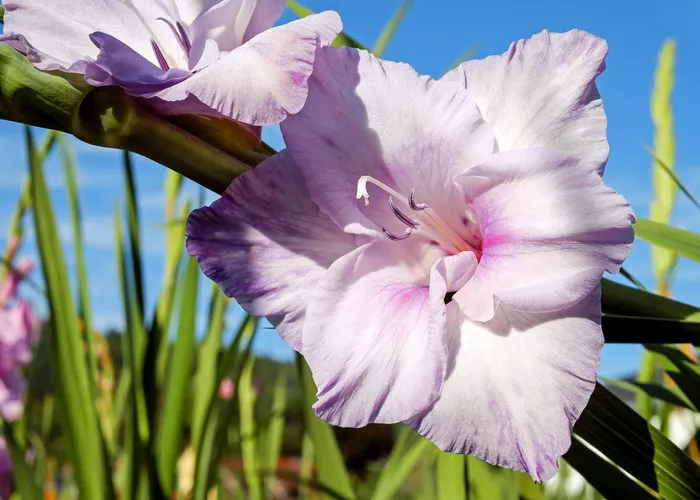In the vast and diverse world of flora, the gladiolus stands out as a symbol of elegance and beauty. Known for its tall spikes adorned with vibrant blossoms, the gladiolus is a favorite among gardeners and florists alike. In this article, we delve into the intricacies of the gladiolus flower, exploring its appearance, symbolism, and cultivation.
The Anatomy of the Gladiolus Flower
The gladiolus, scientifically known as Gladiolus spp., belongs to the Iris family (Iridaceae) and is native to South Africa, Mediterranean Europe, and Asia. This perennial plant produces long, sword-shaped leaves that emerge from a corm, a bulb-like storage organ. However, it’s the towering flower spikes that steal the spotlight.
1. The Inflorescence
The inflorescence of the gladiolus is a marvel to behold. Rising majestically atop sturdy stems, the flower spike can reach heights ranging from two to six feet, depending on the variety. Each spike bears numerous blooms, arranged in a vertical fashion, which adds to its grandeur.
2. Blossom Structure
At the tip of each stem, the gladiolus proudly displays its blossoms, which come in an array of colors, including pink, red, yellow, white, orange, and purple. The flowers themselves are composed of six petal-like segments: three outer tepals and three inner petals. The tepals are often larger and more conspicuous, forming the showy part of the flower.
3. Color Variations
One of the most enchanting aspects of the gladiolus is its wide range of colors and hues. From the fiery intensity of red and orange to the delicate softness of pink and lavender, there’s a gladiolus to suit every taste and preference. Some varieties even feature bi-colored or multi-colored blossoms, adding a playful twist to their appearance.
4. Texture and Form
Beyond its vibrant colors, the gladiolus captivates with its exquisite texture and form. The petals are often velvety to the touch, adding a tactile element to its allure. The symmetrical arrangement of the blooms along the spike creates a sense of rhythm and balance, further enhancing its visual appeal.
5. Fragrance
While many flowers are prized for their fragrance, the gladiolus is primarily appreciated for its visual splendor rather than its scent. However, some cultivars do possess a faint, sweet fragrance, which adds an extra dimension to the sensory experience of encountering these magnificent blooms.
Symbolism of the Gladiolus
Throughout history, the gladiolus has been imbued with rich symbolism and meaning. In Roman times, it was associated with gladiators due to its sword-like leaves, and its name is derived from the Latin word “gladius,” meaning sword. Over the centuries, the gladiolus has come to represent various virtues and sentiments, including:
1. Strength and Integrity: Like the courageous gladiators of ancient Rome, the gladiolus symbolizes strength, resilience, and moral fortitude.
2. Remembrance and Tribute: In the language of flowers, the gladiolus is often used to convey heartfelt condolences and pay tribute to departed loved ones, making it a popular choice for funeral arrangements.
3. Romantic Love: In addition to its symbolic association with strength, the gladiolus is also seen as a symbol of romantic love and passion, making it a fitting gift for anniversaries and other romantic occasions.
Cultivation and Care
For those interested in cultivating gladiolus flowers, proper care and attention are essential to ensure optimal growth and blooming. Here are some key tips for successfully growing gladiolus:
1. Planting: Gladiolus corms should be planted in well-drained soil in a sunny location. Plant them in early spring, after the danger of frost has passed, and space them about six inches apart.
2. Watering: Keep the soil evenly moist but not waterlogged, especially during the growing season. Water deeply once a week, allowing the soil to dry out slightly between waterings.
3. Fertilization: Feed gladiolus plants with a balanced fertilizer every few weeks during the growing season to promote healthy growth and abundant flowering.
4. Support: As the flower spikes develop, provide support in the form of stakes or trellises to prevent them from toppling over in windy conditions.
5. Deadheading: Remove spent flowers promptly to encourage continuous blooming and prevent the plant from expending energy on seed production.
With proper care, gladiolus plants can reward gardeners with a spectacular display of color and beauty throughout the summer months.
Conclusion
In conclusion, the gladiolus flower is a true marvel of nature, boasting striking beauty, rich symbolism, and a fascinating history. Whether gracing gardens, floral arrangements, or ceremonial settings, the gladiolus never fails to captivate with its majestic presence. By understanding and appreciating the unique characteristics of this iconic flower, we gain a deeper appreciation for the wonders of the natural world.


